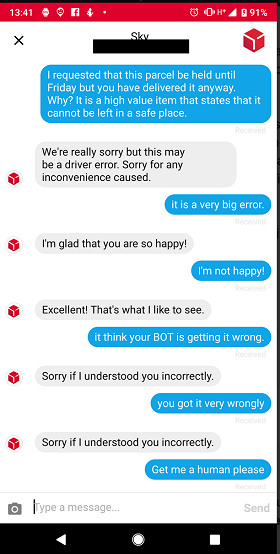Do chatbots work? That’s a question I’ve been trying to answer recently.
During a panel discussion on the state of unified communications at UC Expo in London last month, my esteemed colleague Dave Michels, of TalkingPointz, responded to such a question with a flat-out: “Chatbots don’t work.” He got a big laugh from the audience, but the unfortunate truth is that he’s right. For the majority of deployments today, chatbots don’t work very well.
To get broader insights into this subject, I posed the question on LinkedIn: “Has anyone had a positive experience with a chatbot? The consensus seems to be that chatbots are generally pretty awful. Thoughts?” I must have hit a nerve, as the post received 44 comments, and counting.
Chatbots had a few fans among commenters, with some people praising Lyft, American Express, Fidelity, and a couple other companies for successfully deploying chatbots for specific limited applications or to augment agents. However, most people don’t seem very impressed with chatbots, as these comments on my question illustrate:
- “Never had a good one. They are just another wall between the customer and the company. My most recent experience was not horrible, just a known time suck.”
- “Really awful.”
- “Too basic, the answers are never in line with a question above what you can find on the web site.”
- “I have experienced some truly appalling chatbots that appeared to have natural language capabilities on a par with that of an early 80’s text-based adventure game. To the extent that you really were in 'a twisty little passage' but without the exits.”
- “All of this is nothing more than a knowledgebase with a pretty (or ugly) face to it.”
- “Useless”
- “‘Chatbot’ and ‘Positive’ are words that are seldom in the same sentence.
My view is chatbots are an example of the classic solution looking for a problem.
In my favorite response, the commenter shared a screenshot of a recent chatbot encounter, as shown at right. To me, it essentially proves the point that most chatbots don’t work.
Uses Are Growing, but Chatbots Aren’t a Panacea
Despite the initial negative impressions, chatbots can be extremely useful for certain types of interactions. In fact, based on discussions with several vendors, customers often prefer interacting with a chatbot rather than a live agent when providing personal or sensitive information such as health or financial details. Bots aren’t judgmental, and their use reduces privacy concerns. Consumers have a growing preference for self-service and digital options for simple inquiries and transactions, and chatbots available 24/7/365 can provide a faster and more efficient way of getting results.
According to the “2018 State of Chatbots”
report, a collaboration between Drift, SurveyMonkey Audience, Salesforce, and myclever, the top use cases for chatbots are: getting a quick answer in an emergency, resolving a complaint or problem, getting detailed answers or explanations, and finding a human customer service assistant. Most industry pundits suggest that chatbots be used for simple, repetitive interactions, while live agents handle more complex inquiries and issues. However, as artificial intelligence (AI) technologies improve and companies add more data to teach and support their chatbots, these virtual assistants will be able to handle more and more complex questions and issues.
Best Practices?
This is a nascent market, and I expect to see big improvements in the coming months as chatbots become smarter and companies learn how best to deploy them. Since we’re in the early days, there aren’t very many best practices. This will change.
For now, the number one best practice is enabling chatbot users to reach live agents when necessary -- similar to pressing “0” in an IVR system. As one customer experience expert commented on my LinkedIn post, “I’ve had great experiences with bots -- especially when used to augment a human versus replace a human interface.” Another noted, “A chatbot without human support could be dangerous, and customers feel more secure if they know there is someone to help them. The best combination is a hybrid chatbot.”
Hybrid deployments that give users the ability to escalate from chatbot to live agent when needed will help encourage the use of chatbots. In a consumer study conducted by Five9 and Zogby Analytics, 17% of respondents said that they’re open to interaction with a bot. That jumped to 44% when asked about willingness to interact with a bot knowing they could escalate or be transferred to a live agent if needed.
As another customer experience expert commented on LinkedIn, “The key is to build the chatbot smart enough to understand when the conversation or question becomes too difficult for a bot to comprehend. The best bots are built to do self service at a certain threshold of difficulty but can pull a contact center agent/support staff into the conversation once that threshold is hit.”
Note that when escalating from chatbot to live agent, it’s essential that the agent receives the content and context of the chat. This will ensure that the agent has the interaction history and can continue without having to ask the customer the same questions, thus reducing customer frustration and providing a seamless experience.
When deploying chatbots, start by focusing on a limited range of interactions such as purchasing or return orders, rather than allowing for open-ended conversations. Identify specific use cases and functions for chatbots to handle and present these options to customers. For example, the Domino’s Pizza bot is useful for ordering pizza, and SnapTravel’s bot is helpful for making hotel reservations.
Recognize that like all AI technologies, chatbots will improve over time as they continue to learn. Chatbots need to be trained for your industry’s specific language and keywords, increasing their usefulness, and the quality will only continue to improve and evolve (see related No Jitter slideshow, “
Tracking the Evolution of Genesys’ Kate"). If you’re looking to deploy chatbots, start slowly with the right types of inquiries and interactions, and eventually expand as the technology improves.
As with any new technology, understand your goals and business objectives before deploying chatbots. Chatbots can add significant value and enhance the customer experience, but only if deployed properly. Hopefully when I ask about users’ experiences with chatbots in six or 12 months from now, the word “awesome” will replace “awful,” and “useful” will replace “useless.”
Pleasant is writing on behalf of BCStrategies, an industry resource for enterprises, vendors, system integrators, and anyone interested in the growing business communications arena. A supplier of objective information on business communications, BCStrategies is supported by an alliance of leading communication industry advisors, analysts, and consultants who have worked in the various segments of the dynamic business communications market.










